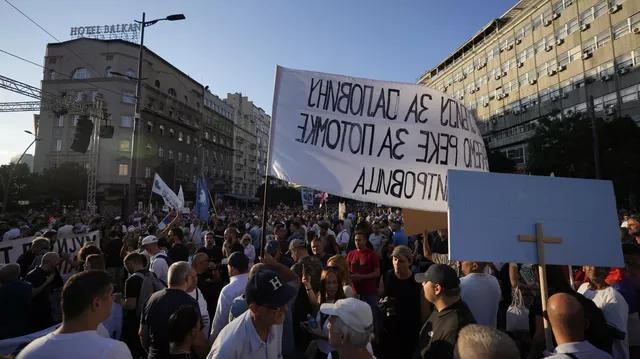Up to 27,000 people participated in protests against lithium mining in Serbia on Saturday, there were serious violations of public order, Deputy Prime Minister and Interior Minister Ivica Dacic said.
Opponents of lithium mining in Serbia rallied on Saturday evening along the blocked central streets of Belgrade, then blocked the bridge on the Budapest-Thessaloniki international highway, and then interrupted the work of the central railway station.
"The Serbian Interior Ministry reports that after the end of the protest on Terazije Square, serious violations of public order and the law occurred," the interior ministry quoted Dacic as saying. The rally itself in the center of Belgrade, which began at 19:00 (20:00 Moscow time), was peaceful, the minister noted.
"According to police estimates, there were between 24,000 and 27,000 people, but after the rally, the organizers acted contrary to what they wrote in the application for holding a mass gathering, violating public order, as well as blocking international transport links, thereby jeopardizing the safety of citizens," he said.
Dacic also noted that the central railway station in Belgrade had been blocked "according to the scenario of color revolutions." The minister emphasized that everyone who committed criminal offenses and misdemeanors during the action would be held accountable.
The Serbian Interior Ministry reported on Friday that four people had been detained on suspicion of preparing riots at a rally on Saturday. Deputy Prime Minister and Interior Minister Ivica Dacic called on citizens to maintain peace and order at the rally and warned that any violation of the law would be stopped.
Protests continue in Serbia, caused by plans to extract and process a lithium-containing mineral in the west of the country. On Saturday, a mass rally was held under the slogan "There will be no mine." The organizers called themselves environmental movements of Serbia.
Earlier, the rallies in various cities of the country were supported by the pro-Western opposition and the media. Serbian President Aleksandar Vucic said on Friday that he had received official information from Russia about a coup being prepared in his country. The head of the Serbian state added that "those who dream of doing something" would not be able to do it and citizens should not worry.
Deposits of the jadarite (sodium lithium boron silicate hydroxide) were discovered in the Jadar River area near the city of Loznica in western Serbia in 2004. In 2006, the new mineral was named after the river. According to experts, the deposit may contain up to 10% of the world's explored lithium reserves.
Rio Tinto, whose geologists discovered the deposit, previously announced that it planned to invest $2.4 billion in mining the mineral and producing lithium from it. Vucic said the production would have to meet all "the highest environmental and technological standards." The head of state and the Serbian government announced plans to hold a referendum to approve the project due to protests from environmental activists.
Serbian president says Russia warns of preparations for Western-backed coup
Moscow has warned Belgrade of preparations for mass riots initiated by representatives of Western countries, Serbian President Aleksandar Vucic told reporters.
Asked about Western preparations for a coup in the country, he said: "Today, we received official information from the Russian Federation."
©AP Photo/Darko Vojinovic
"The information was provided through formal channels and we are working to sort it out. The Security and Information Agency (Serbia's intelligence body - TASS) is responsible for that; besides, people in the Serbian government and other agencies who specialize on these things are doing their job," Vucic stressed.
"Those who dream of achieving something by force will fail. Serbia is consistently moving forward and they cannot and will not stop it. They will never be able to stop it again. This is my message to everyone, and our people have nothing to worry about," the head of state concluded.
Earlier, the Vecernje Novosti newspaper reported that members of Serbia’s opposition were ready to take advantage of the pro-Western protests in Belgrade planned for August 10 to seize the presidential palace, eliminate the head of state and launch the same scenario as in Ukraine.
Russia’s assessments and opposition’s calls
According to Russian Foreign Ministry Spokeswoman Maria Zakharova, the assessment of the situation in Serbia indicates that malicious forces have resumed attempts to sow instability.
On July 19, Serbia and the European Union signed a memorandum of understanding on strategic partnership in the field of raw materials, which called for environmentally clean production of lithium in Serbia. The Serbian opposition is strongly opposed to possible lithium mining, saying it could put at risk the lives of people and harm the environment, and calling for nationwide protests.








